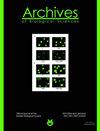Combined analysis of KARS mutation and p16INK4a and p14ARF methylation status in locally advanced rectal carcinoma treated with preoperative chemoradiotherapy
IF 0.8
4区 生物学
Q4 BIOLOGY
引用次数: 0
Abstract
Current management of locally advanced rectal carcinoma (LARC) involves preoperative chemoradiotherapy (preCRT) before surgery. Despite improved local control rate, the response to preCRT of individual patients is variable and may reflect heterogeneous biological properties among tumors of the same clinical stage. Identifying novel molecular parameters with predictive and/or prognostic value is of great clinical importance for a personalized therapeutic approach. In this study, KRAS mutation status was analyzed by direct sequencing, while methylation-specific polymerase chain reaction (MSP) was used to examine p16INK4a and p14ARF gene methylation status in pretreatment tumor biopsies of 60 patients with LARC. The examined molecular changes of KRAS, p16INK4a and p14ARF genes were mutually independent (p16INK4a/KRAS, P=0.272; p14ARF/KRAS, P=0.923; p16INK4a/p14ARF, P=0.715). However, the simultaneous presence of p14ARF methylation and KRAS mutation was associated with a more frequent appearance of local recurrences and distant metastasis (P=0.027). Moreover, patients with the simultaneous presence of p16INK4a and p14ARF methylation and KRAS mutation had significantly shorter overall survival (P=0.011). The obtained results strongly suggest that combined analyses of examined genetic and epigenetic molecular alterations could contribute to the identification of LARC patient subgroups with more aggressive tumor behavior and worse disease outcome.局部晚期直肠癌术前放化疗中KARS突变与p16INK4a和p14ARF甲基化的联合分析
目前局部晚期直肠癌(LARC)的治疗包括术前放化疗(preCRT)。尽管局部控制率有所提高,但个体患者对preCRT的反应是可变的,可能反映了同一临床分期肿瘤的异质生物学特性。识别具有预测和/或预后价值的新分子参数对于个性化治疗方法具有重要的临床意义。本研究通过直接测序分析KRAS突变状态,同时采用甲基化特异性聚合酶链反应(methyl- specific polymerase chain reaction, MSP)检测60例LARC患者肿瘤活检前p16INK4a和p14ARF基因甲基化状态。所检测的KRAS、p16INK4a和p14ARF基因的分子变化相互独立(p16INK4a/KRAS, P=0.272;p14ARF /喀斯特,P = 0.923;p16INK4a分子/ p14ARF, P = 0.715)。然而,p14ARF甲基化和KRAS突变同时存在与更频繁的局部复发和远处转移相关(P=0.027)。此外,同时存在p16INK4a和p14ARF甲基化和KRAS突变的患者总生存期显著缩短(P=0.011)。所获得的结果强烈表明,对所检查的遗传和表观遗传分子改变的联合分析可能有助于识别具有更强侵袭性肿瘤行为和更差疾病结局的LARC患者亚组。
本文章由计算机程序翻译,如有差异,请以英文原文为准。
求助全文
约1分钟内获得全文
求助全文
来源期刊
CiteScore
1.40
自引率
0.00%
发文量
25
审稿时长
3-8 weeks
期刊介绍:
The Archives of Biological Sciences is a multidisciplinary journal that covers original research in a wide range of subjects in life science, including biology, ecology, human biology and biomedical research.
The Archives of Biological Sciences features articles in genetics, botany and zoology (including higher and lower terrestrial and aquatic plants and animals, prokaryote biology, algology, mycology, entomology, etc.); biological systematics; evolution; biochemistry, molecular and cell biology, including all aspects of normal cell functioning, from embryonic to differentiated tissues and in different pathological states; physiology, including chronobiology, thermal biology, cryobiology; radiobiology; neurobiology; immunology, including human immunology; human biology, including the biological basis of specific human pathologies and disease management.

 求助内容:
求助内容: 应助结果提醒方式:
应助结果提醒方式:


